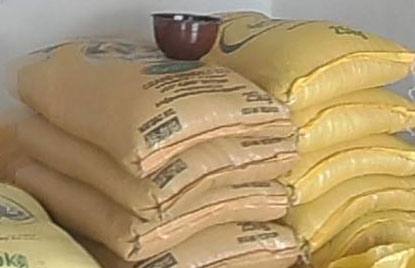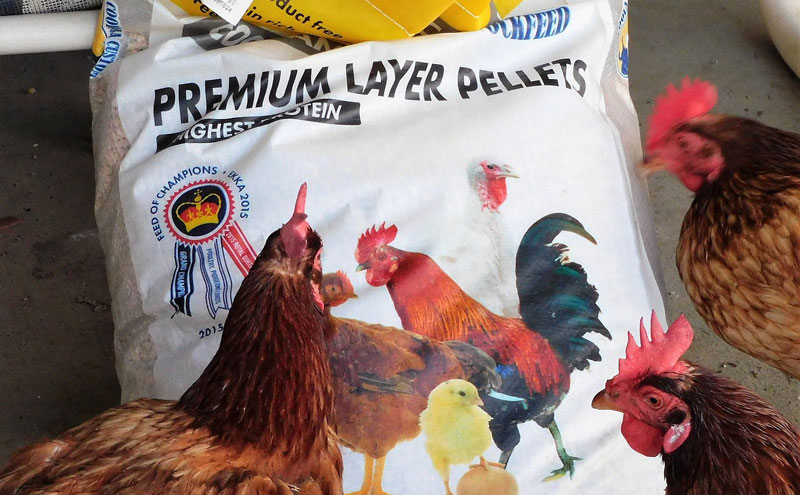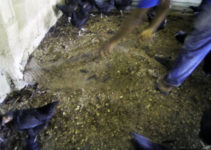7 Reasons Why You Should Use Commercially Formulated Poultry Feeds

commercially formulated poultry feeds
As poultry farming begins to grow over the years, many poultry farms kept flocks too large to be fed in the natural homestead way, these led to the establishment of a standard feed mill that will meet the nutritional needs of poultry birds both in quantity and quality.
Modern feeds for poultry consist largely of grain, and protein supplements such as soybean oil meal, lysine, methionine, threonine, tryptophan, premix, mineral supplements, and vitamin supplements.
Feed formulation has gone through vast improvements from simple hand formulations to computerized formulations using modern software equipped with advanced capabilities, which allows for high accuracy, easy integration, and flexibility.
This has led to an increase in the quality and quantity of poultry birds, in terms of fast weight gain (broilers), increase in egg production( layers) etc.
In general, modern commercially formulated poultry feeds are based on the concept of ‘least-cost’ and produced using linear programming by experts.
When it comes to poultry farming so many people have misgivings, especially on the issue of feeds and feeding of poultry birds.
Feeding accounts for approximately 50% of the total cost of poultry production.
These calls for concern to many poultry farmers, due to the huge financial involvement most poultry farmers always seek a cheaper cost-effective means of raising their poultry birds.
This necessitated the need to source other alternatives that will reduce drastically the cost of raising poultry birds.
So many things could go wrong if the feeds are not properly formulated, off course this will affect the profit margin of the whole project of raising the poultry birds.
It becomes absolutely necessary that you fully understand why you should not go ahead to formulate your own feeds if you do not have the technical and financial resources to do so.
And if you don’t have a large farm, it is not economically viable to produce your own poultry feeds due to the following reasons:
-
Non Commercially Formulated Poultry Feeds Lacks Enough Nutritional Balance For Weight Gain And Good Results
Many small-scale farmers or rather backyard farmers make do with the little resources available at their disposal.
They just get the basic ingredient such as maize, soymeal and wheat offal.
Other micronutrients, trace elements that are essential for maximum growth and production might be beyond the reach of many smallholder farmers i.e. cannot be found within their locality.
Thus making them go ahead to formulate the poultry feeds with what is available. These will suddenly lead to poor-quality feeds that will have a negative impact on the general performance of the birds.
But the big larger feed mill has both the financial and logistics to source all the substances/ingredients needed for the production of well-balanced diets for poultry feed.
Recommended for you:
13 Important Tips for Good Feed and Water Management in Poultry Farming
Five (5) Solid Ways You Can Create Wealth through Poultry Farming
8 Proven Ways On How to Starts and Maintain A Poultry Farm

A well-formulated poultry feeds.
-
Locally Prepared Poultry Feeds Might Not Take Cognizance Of The Presence Of Mycotoxin Compared To Commercially Formulated Poultry Feeds
As a result a lot of poultry farmers trying to cut corners in the poultry business by formulating their own feed.
They end up using poisonous ingredients i.e. maize ignorantly without knowing that it has gone bad, infested by mycotoxins.
As a simple fact, the poultry industry especially in sub-Saharan Africa is faced with feed insecurity, associated with the high cost of feeds.
And feed safety, associated with locally produced feeds often contaminated with mycotoxins.
Mycotoxins, including aflatoxins (AFs), fumonisins (FBs), trichothecenes, and zearalenone (ZEN), are common contaminants of poultry feeds and feed ingredients from most parts of Africa.
These mycotoxins cause serious damage to the health and productivity of chickens and poultry in general.
It can also be present in poultry food products, posing a health hazard to human consumers.
In view of this stack reality, it becomes pertinent that local poultry farmers should instead use commercially formulated poultry feeds for optimal results.
These commercially formulated poultry feeds are usually produced by high-standard feed mills that have well-established quality control mechanisms in place.

A well-formulated pelleted commercial feed has all the nutrients caked in one piece
-
Poor Storage System
Most poultry farmers especially in sub-Saharan Africa lack good and proper storage systems. Especially airtight containers that can effectively store grains and feed ingredients even the feeds itself.
The locally formulated feeds end up being infiltrated by rodents, moulds, and bacterial-carrying insects that will adversely affect both the nutritional quality of the feeds and their palatability and freshness.
Farmers will do themselves a lot more good by commercially formulated poultry feeds from a reputable feed mill in batches according to their needs, to avoid undue contamination.
Recommended for you:
Noiler Farming In Nigeria, the New Game Changer
6 Important Lessons I Learned About Raising Noiler Chickens
How to Successfully Brood Noiler Chicks
-
Difficulty In Getting The Various Ingredients Which Is Not The Case With Commercially Formulated Poultry Feeds
A Well formulated, standard poultry feed comprises various ingredients to ensure a balanced diet, ranging from grains, proteins, fibre, protein supplements, vitamins, minerals etc.
The unavailability of both quality and quantity of feed is a major problem when it comes to feeding poultry and increasing the production of poultry.
Cereal grains which make up the bulk of poultry rations are deficient in critical amino acids like lysine, methionine, threonine and tryptophan.
All these ingredients or substances that make up well-formulated feeds are not easy to come by.
The poultry farmer may end up using what is available or rather what he has i.e. available resources.
These may result in poor, less quality feeds lacking in essential minerals and vitamins.
This will adversely affect the general well-being of the poultry birds. This certainly will lead to frustration on the part of the farmer.
Because he will certainly notice stunted growth, poor weight gain, and disease-infested folk.
Now the established feed mill already have mechanism put in place to source these vital ingredients of feeds.
They also have the financial backing to purchase this item in large wholesale quantity, and even at a cheaper rate, to the detriment of the local farmers.
Who has to buy everything at retail price, which is often too expensive for his farm project, and might end up affecting the overall profit margin.
Recommended for you:
6 Simple Ways You Can Prevent Basic Turkey Diseases
Turkey: The Benefit and Beauty of Adding This Wonderful Bird to Your Homestead Flock.
5 Reasons Why Turkey Farming Is a Good and Dependable Source of Income
-
Poultry Feed Production Has Gone Scientific
The established poultry feed mill has expatriate, veterinary expert, and livestock nutritional experts, that will advise accordingly based on standard scientific research and findings, using standard mixing formula that will yield excellent results.

- Lack Of Proper Mixing (Good Industrial Mixer) Of The Various Ingredients
This is a severe problem for smallholder farmer that most often has to mix the feed manually by themselves or their farm workers.
In the production of feeds by a standard feed mill, they used an industrial mixer for the even distribution of various macro and micronutrients contained in feeds for maximum utilization by poultry birds.
Without proper mixing (good industrial mixer) most birds will end up with substandard feeds which will translate to poor growth rate, poor weight gain, and poor immunity.
Recommended for you:
13 Best Ways to Disinfect, and Clean Poultry Houses.
Why I’m Excited about My Next Batch of Poultry Birds
The 5 Lessons I Learned In Poultry Production the Hard Way from My Twelve 12 Years of Farming
- Varieties Give Room For More Innovation And Quality Feeds
Many Feed mills are springing up every day giving room for competition, quality and even some sort of price control.
Formulating feeds yourself will force you to accept whatever the outcome of the feed you have formulated.
References
https://www.ncbi.nlm.nih.gov/pmc/articles/PMC8473361/







